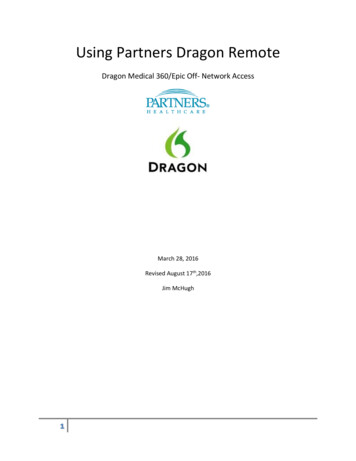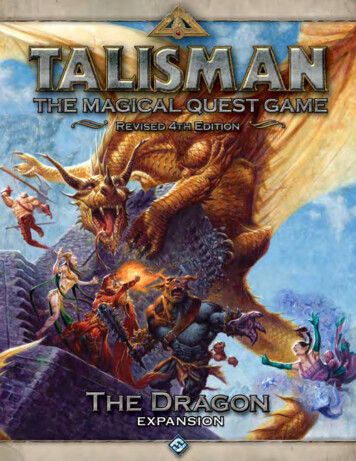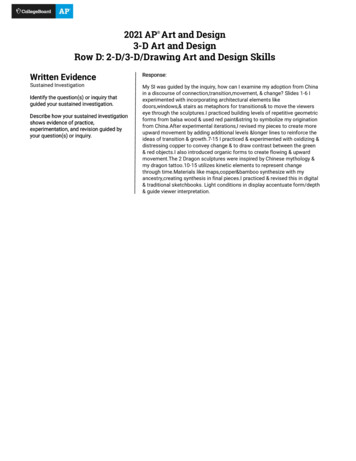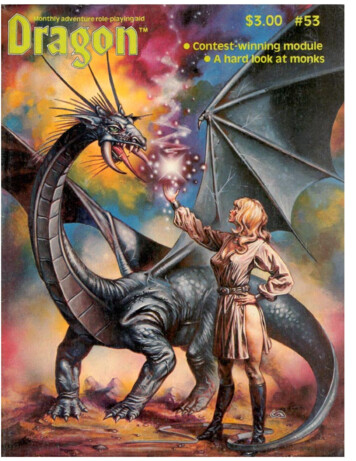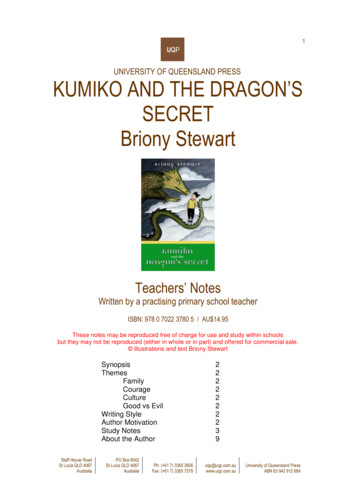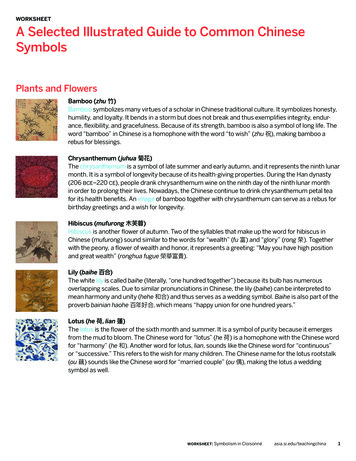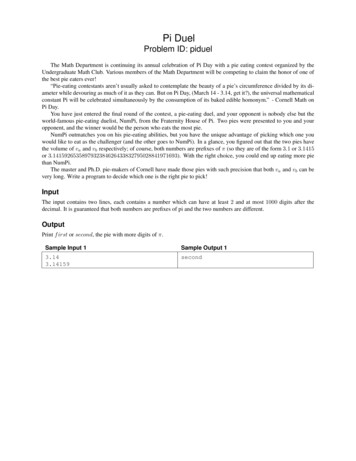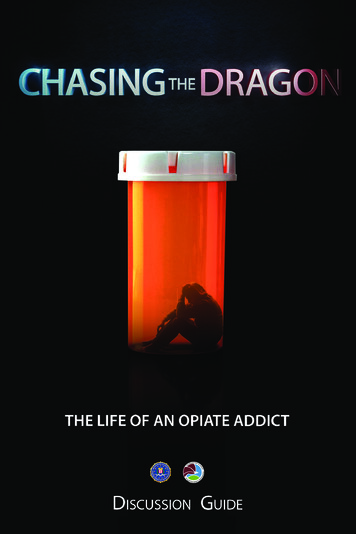
Transcription
Dear Educator,On behalf of our two agencies, we would like to thank you for incorporatingChasing the Dragon: The Life of an Opiate Addict into your school’scurriculum. The opioid and prescription drug abuse epidemic that issweeping the country is a problem unlike anything we have seen before. Wecreated this documentary to help students develop a greater understandingof this crisis to create a deeper appreciation about the dangers of opioidaddiction. Our goal is to reach youth before an addiction can set in.We have worked with educators to create a study guide to supplement thedocumentary. We believe the enclosed guide will help stimulate thoughtfuland honest dialogue about this epidemic. Through these conversations, wehope to prevent additional students from becoming victims.We thank you for your help in spreading this message to students, parents,and fellow educators about this horrible epidemic. If, as you begin toimplement this documentary into your classrooms, you find that you needadditional resources on this topic, or if you would like experts from ourrespective agencies to speak in your schools, please contact your local FBI orDEA field office. We stand ready to help.Sincerely,James B. ComeyFBI DirectorChuck RosenbergActing DEA Administrator
CHASING THE DRAGONPURPOSE AND OBJECTIVES:This documentary gives a face to the lurking evil of opiate addiction thatstatistics measure to be at epidemic levels. Federal, state, and local lawenforcement officers are asking educational institutions across the countryto inform teenagers of the hazards of drug abuse and expose the truth aboutthe opiate epidemic.The purpose of this film and follow-up activities is to raise awarenessof drug abuse and the profound downward spiral that can be caused byopiate addiction. The film content has been provided by actual people whoabused opiates or whose children abused opiates. They selflessly shared theirunfiltered, impassioned, unscripted, and painful accounts to try to stopother people from taking drugs and destroying lives.The objectives of the discussion guide are to have students process andinteract with the content covered in the film and then answer questions todemonstrate their understanding of the material. Some of the questions askfor direct recall of information while others require students to synthesizecontent and respond. An affective objective—or one that is influenced byemotions—is to have students reflect on how their own lives and lives offamily members could be ruined if they or their friends were addicted toopiates. Discussion facilitators should ask students to share their personalfeelings, thoughts, and concerns. A final objective is to get students to beproactive in the fight against drug abuse. A set of culminating activities asksstudents to integrate ideas by designing diagrams, writing proposals, usingsocial media, creating art projects, and planning initiatives.Students are not watching this film, answering questions, and completingprojects to pass a test; they are doing this to save lives—maybe even theirown.The film includes strong language, intense content, and graphic images.An example of an opt-out form and parental waiver can be downloaded atwww.fbi.gov/ChasingTheDragon for schools to send home with studentsshould administrators choose to do so.Discussion GuideTERMS AND DEFINITIONS:Banging – slang for a procedure involving the injection of a solutioncontaining heroin or prescription opioids directly into the bloodstream.Chasing the Dragon – expression given to the pursuit of the original orultimate but unattainable high, which can lead to a dangerous spiral of legaland health consequences.Dope – slang for heroin.Heroin – an opioid drug that is synthesized from morphine, a naturallyoccurring substance extracted from the seedpod of the Asian opium poppyplant.1Opiates/Opioids – drugs (such as heroin) derived from compoundsfound in the opium poppy plant, or synthetic drugs (such as prescriptionpainkillers) that contain substances that mimic these compounds. Theseterms are often used interchangeably.Oxycodone – a semi-synthetic narcotic analgesic that is a popular drug ofabuse. It is synthesized from thebaine, a constituent of the poppy plant.2Tolerance – a state in which a person no longer responds to a drug and ahigher dose is required to achieve the same effect.3Withdrawal – the wide range of symptoms that occur after stoppingor dramatically reducing opiate drugs after heavy and prolonged use.Symptoms include but are not limited to agitation, anxiety, sweating, bodyaches, abdominal cramps, nausea, vomiting, and diarrhea.41234Page 4“Heroin,” National Institute on Drug Abuse, last modified March 2015, http://www.drugabuse.gov/drugs-abuse/heroin.Drugs of Abuse, 2015 Edition (Drug Enforcement Administration, 2015), 43, accessed January19, 2016, ons/drug of abuse.pdf.“The Neurobiology of Drug Addiction,” National Institute on Drug Abuse, last modified January 2007, n-heroin-morphine/6-definition-tolerance.“Opiate withdrawal,” MedlinePlus, U.S. National Library of Medicine, last modified April 5,2013, 00949.htm.Page 5
CHASING THE DRAGONCENTRAL THEMES:The film organizes the interviewees’ testimony along a series of centralthemes showing how people become addicted to opiates and the severeconsequences of addiction. Students should identify these themes, listedbelow, during class discussion of content covered in the film.Everyone is at risk of opiate addiction—it does not discriminate. Theopiate epidemic has spread rapidly due to a false perception that onlycertain demographics are at risk. Persons of all life circumstances becomevictims each day. High school students are no exception.Opiate addiction can occur quickly, and, in most cases, individualsfirst become addicted by abusing pain pills. Prescription drugs are veryaccessible and can rapidly lead to addiction if abused.A life-consuming routine that revolves around seeking opiates emergesonce a person becomes addicted. It is this routine that is best described bythe expression “chasing the dragon.”Increasing tolerance to opiates can often lead to a more costly anddangerous addiction in terms of quantity, substance type, and method ofabuse. It is this dynamic of opiate addiction that can cause individuals totake greater and greater risks as they pursue the unattainable experience ofthe first high.Discussion GuideHealth consequences from opiate abuse are prevalent and severe.Bloodborne pathogens, infections, permanent injury due to overdoses, andother health issues make opiate addiction extremely dangerous.Withdrawal from opiates is often extremely difficult and represents asignificant challenge to breaking the cycle of abuse. Addicted persons oftenfind their pursuit of opiates is no longer for the purpose of getting high butto avoid experiencing the symptoms of withdrawal.Overdoses are common. Misconceptions exist that overdoses are onlyassociated with abuse of large quantities of drugs. The risk of overdose isreal and can occur at any point in the cycle of abuse.Death can be a tragic consequence of opiate abuse. The victims of anopiate overdose resulting in death include not only the deceased but also thefamily and friends left in the wake of losing a loved one.Saying no to abusing opiates—or any drug—is a primary strategy to staysafe. Peers should support each other in making wise choices and countering the pressures placed on young people today.Help is available to those who need it. Opiate addiction is not generallysomething someone can overcome alone, and we should all help ensureanyone who is struggling finds the resources he/she needs.Legal consequences often result from the lengths users will go tosupport their opiate habit. The grip of addiction can lead an ordinarilylaw-abiding person to cross legal boundaries he/she would normally haverespected—many opiate-addicted individuals turn to theft, fraud, andprostitution to obtain drugs. The public harm associated with opiate abusehas many forms, affecting more than just the addicted persons themselves.Page 6Page 7
CHASING THE DRAGONSTATISTICS:Discussion Guide The testimonies in the film are representative of what statistics have shownto be a widespread epidemic. The film presents the following statisticsbetween sections to reinforce themes or express the magnitude of theproblem described by the interviewees. Approximately one in five high school seniors reports misusingprescription drugs at least once in their lifetime.1 A 2014 national survey found an estimated 1.4 million people in theU.S. abused a prescription painkiller for the first time that year.2 Most first-time abusers of painkillers obtain them from a friend orrelative.3 Nearly all people who use heroin also use at least one other drug.4 1234Richard A. Miech, Lloyd D. Johnston, Patrick M. O’Malley, Jerald G. Bachman, John E. Schulenberg, Monitoring the Future: National Survey Results on Drug Use, 1975-2014: Volume I,Secondary School Students (Ann Arbor: Institute for Social Research, The University of Michigan,2015), 218, -vol1 2014.pdf.Center for Behavioral Health Statistics and Quality, Behavioral Health Trends in the UnitedStates: Results from the 2014 National Survey on Drug Use and Health: Detailed Tables(2015), Table 1.1A, UH-DetTabs2014/NSDUH-DetTabs2014.pdf.Substance Abuse and Mental Health Services Administration, Results from the 2013 NationalSurvey on Drug Use and Health: Summary of National Findings (Rockville, MD: SubstanceAbuse and Mental Health Services Administration, 2014), 3, istopher M. Jones PharmD, Joseph Logan, PhD, R. Matthew Gladden, PhD, Michele K.Bohm, MPH, “Vital Signs: Demographic and Substance Use Trends Among Heroin Users— United States, 2002-2013,” Morbidity and Mortality Weekly Report 64, no. 26 (2015): 719725, htm.Page 8567People who take prescription painkillers can become addicted withjust one prescription.5A large percentage of individuals arrested for major crimes—including homicide, theft, and assault—are under the influence of illicitdrugs.6In the 1960s, more than 80% of opioid abusers got hooked on heroinfirst. In the 2000s, 75% of opioid abusers started with prescriptionopioids.7More than 10 million people 12 years and older in the U.S.reported nonmedical use of prescription opioids in 2014.2Each day, 44 people in the U.S. die from an overdose of prescription painkillers.5More than 93% of those identified as needing treatment for dependence or misuse of an illicit drug believe they do not need help.2“Understanding the Epidemic,” Centers for Disease Control and Prevention, National Center forInjury Prevention and Control: Prescription Drug Overdose, last modified October 28, stance Abuse: The Nation’s Number One Heath Problem (Waltham, MA: Schneider Institute for Health Policy, Brandeis University, 2001), 67, ts/2001/rwjf13550.Theodore J. Cicero, PhD, Matthew S. Ellis, MPE, Hilary L. Surratt, PhD, Steven P. Kurtz, PhD,“The Changing of Heroin Use in the United States: A Retrospective Analysis of the Past 50Years,” JAMA Psychiatry 71, no. 7 (2014): 821-826, leid 1874575.Page 9
CHASING THE DRAGONDiscussion GuideINTERVIEWEE PROFILES:After students view this film, a class discussion—led by a school resourceofficer, teacher, administrator, or counselor—is recommended.The storyline of the film portrays the progression of opiate addictionaccompanied by the escalation of consequences, as told by the interviewees.The discussion guide’s questions require students to recall information fromthe film. This profile sheet will assist students in making reference to theappropriate interviewee during the discussion; it can be downloaded at:www.FBI.gov/ChasingTheDragon.Katrina – Former business executive and motherof two who became addicted to opiates afterself-medicating with pain pills and alcohol.Sarah – Began using marijuana at age 13 andbecame addicted to opiates after being prescribedoxycodone for injuries related to an automobileaccident.Trish – Mother of Cierra, an A/B honor rollstudent who took opiates while in high school andbecame addicted.Page 10Matt – Began using marijuana at age 11 andbecame addicted to opiates at age 15.Julia – Involved in many school activities andwas an honor roll student. She began usingmarijuana at age 11 and eventually used otherdrugs. She overdosed on opiates four times.Cory – Enjoyed outdoor activities and was anEagle Scout. He first used marijuana and eventuallytried other drugs. He was addicted to opiates byage 17.Melissa – Began using marijuana at age 13 andgot hooked on oxycodone after a pregnancy. Shewas arrested on eight occasions for drug abuse andsuffered numerous health issues due to multipleoverdoses.Page 11
CHASING THE DRAGONDISCUSSION QUESTIONS:A list of questions is provided below to help organize the discussion in amanner that will help students discover the critical points of the film anddraw conclusions they can use to develop strategies to avoid drug abuse.(It may be helpful to write the highlighted themes on the board as they areidentified during discussion.)Discussion GuideQuestion 3:What were the ways the people in the film got hooked on opiates?Theme Development: Question 1:The film began with a statistic: “Approximately one in five high schoolseniors reports misusing prescriptions drugs at least once in their lifetime.”Using our class as an example, how many students would that be?Theme Development: Show physically by row or number of seats in the classroom how manystudents the answer represents. The purpose of this demonstration is toget students to recognize this conversation is relevant to them.Question 2:Question 4:Many argue that using alcohol, marijuana, or other seemingly “minor”drugs acts as a gateway to stronger, more lethal drugs and addictions. Inhearing the real stories of the addicted persons in this video, do you believethere is support for this claim?Theme Development: What did the opiate-addicted individuals in the film have in common priorto becoming addicted? Theme Development: Draw attention to answers highlighting that the addicted persons inthe film had normal and, in some cases, even privileged lives.Point to the conclusion that everyone is at risk if not informed.Some students may identify that most persons used marijuana or otherdrugs prior to abusing opiates. This issue will be addressed in questionsthree and four.Page 12The two “typical” paths leading to opiate abuse are depicted in thefilm. Some people start using other drugs, which can eventuallylead to the use of opiates. Others self-medicate outside the boundsof legitimate medical oversight, often after first having a legitimateprescription.The interviewee profile sheet and video testimonies show a prevalenceof marijuana use prior to opiates.Statistic: “Nearly all people who use heroin also use at least one otherdrug.” (Vital Signs, MMWR 2015)Discuss the impact of impaired judgment from abuse of drugs oralcohol and how that may lower inhibitions to try an opiate.Page 13
CHASING THE DRAGONDiscussion GuideQuestion 5:Question 7:What influence did friends have on the interviewees’ use of drugs?How did the people in the film describe their daily routine once opiateaddiction set in?Theme Development: Sarah: “I met the crowd who did do stuff. You are who you hang outwith.”Matt: “My buddy said, ‘Hey, these will get you high. Let’s do some.’ Iwas like, okay.”Trish: “ the friends helped pick the road that she (Cierra) chose.”Theme Development: Question 6:What did you learn about how fast someone can become addicted? Ifsomeone said to you, “But it’s only one pill—you can’t get addicted fromjust one,” how would you respond?Theme Development: All interviewees described becoming addicted quickly and needingmore and more opiates. Remember, if someone is taking these drugs,they are not “trying”—they are actually “doing.”Katrina: “I feel I became addicted that day.”Statistic: “People who take prescription painkillers can becomeaddicted with just one prescription.” (CDC, 2015)Point to the theme that opiate addiction can occur quickly.Dr. Bassam: “You can’t maintain an opiate addiction and a normal lifefor very long.”Cory: “I started stealing from my family and friends. Whatevermoney I had in my pocket was all going to it.”Sarah: “It’s a never-ending, vicious cycle. It’s the same thing, over andover and over.”Julia: “Your whole day revolves around it. You go to sleep doing it. Youwake up doing it.”Melissa: “It became my full-time job. The needle was my boss—a verydemanding boss.”All the persons in the film describe a life-consuming routine. Talk tostudents about how an opiate addiction would interfere with theirdaily lives, including consequences they can relate to. Discuss impacton sports and activities, loss of friends, ability to remain in school, etc.Question 8:What did Cory mean when he said he was eventually just taking opiates to“stay well”?Theme Development: Page 14Students should identify that the interviewees describe an initial pursuitof getting high, which ultimately becomes more difficult to achieve dueto an increasing tolerance to opiates. Eventually, opiate-addicted personsneed to take the drug to simply keep from going through withdrawal.Katrina: “I couldn’t even function without 40 pills a day. I was ill likeliterally every four hours. The chills started setting in and I wokeup sick.”Page 15
CHASING THE DRAGONDiscussion GuideQuestion 9:Question 10:Since addicted persons need more and more prescription painkillers to gethigh or “stay well,” what are some consequences they may face that youlearned about from the film?What are the similarities and differences between prescription opiates andheroin?Theme Development:Similarities: Both are opiates and highly addictive. Both can be abused in similar manners. Both are easily accessible. Trish felt her daughter was able to obtain theheroin more easily. Katrina: “There is absolutely no difference in my mind between aheroin addict and pill addict. We both will do anything to get it. You’re both addicted; you both go through the withdrawals.” Julia: “It’s all the same. One is prescribed to you, and one you gocop on the street.” Persons addicted to prescription painkillers often turn to moreaggressive methods of ingesting the drugs (oral, smoking, snorting,injecting). Eventually, many will turn to heroin, which is cheaperthan pills.People addicted to opiates might turn to theft, prostitution, or othercrimes to obtain money to finance their addiction. The grip of addictioncan lead an ordinarily law-abiding person to cross legal boundaries he/she would normally have respected.Ask for examples from the film of uncharacteristic or illegal behavior asa result of addiction: Matt: Prescription fraud Cory: Stole from family and friends Sarah: Prostitution Julia: Turned to stripping Katrina: Prescription fraud Cierra: Turned to stripping, stole checks from grandmother, theftfrom family, spent 800 a week, convicted felon at 18Point out the prevalence of legal consequences, like incarceration,among the interviewees, including the fact that Sarah, Melissa, andJulia are in jail during their interviews.Discuss the potential impact on a person’s future from a felonyconviction: Career limitations – clearances, military, positions of trust Cannot vote Cannot own a firearm Social stigmaPage 16Theme Development:Differences: Heroin is often cut with harmful substances like meat tenderizer,which can lead to major tissue damage, dangerous infections, loss oflimbs, cardiac arrest, and other severe health consequences. The strength of heroin can be unpredictable, resulting in frequentoverdoses. Heroin is cheaper and has no medical use. Prescription opiates can be used for legitimate medical purposes.Page 17
CHASING THE DRAGONDiscussion GuideQuestion 11:Question 13:What were the main reasons users switched from prescription painmedicine to using heroin?How did people in the film describe opiate withdrawal?Theme Development: Theme Development: Cost is one of the main reasons. Heroin is a cheaper substitute.Sarah: “You can get four shots for the price of one pill.”Matt: “ then you go for heroin because it’s cheaper.”Cory: “It was cheaper, so of course I got into it.”Trish: “I think she was able to access more heroin easily [sic] than thepills” Ms. Taylor (expert): “ withdrawal looks like extraordinary physicaland muscular pain, and very few people can actually manage it.”Matt: “You feel like you just want to die.”Cory: “It’s just something I never want to experience again. It is theworst feeling ever.”Sarah: “You will do anything to make it stop.”Julia: “ 15 times worse than the flu. You would seriously probablyrather just be dead.”Katrina: “It was horrific.”Question 12: What were some of the health consequences of opiate abuse discussed bythe persons in the film?Question 14:Theme Development:What did Melissa do after she overdosed on heroin and had to be revivedusing a defibrillator? Health consequences discussed in the film include:Hepatitis C and other bloodborne pathogensMRSA infectionsAbscessesOverdosesTheme Development: Page 18Melissa left the hospital and purchased some of the same heroin thathad just caused her to go into cardiac arrest.Ask students what this example suggests about the implications ofopiate abuse on rational thought.Even though overdoses are common among opiate abusers, this realityis still not enough to deter continued abuse by many.Page 19
CHASING THE DRAGONDiscussion GuideQuestion 15:Question 17:Were Kirstyn and Cierra the only victims when they passed away?What advice did we get from the interviewees at the end of the film?Theme Development:Theme Development: Point out the broader tragedy of death as a result of narcotics overdose.Katrina: “I am still in shock.”Trish: “ this doesn’t just affect you. It affects everybody in your familyfor the rest of their lives. That we’re the ones stuck here missing you.” Question 16:Katrina said that the kids in attendance at Kirstyn’s funeral were high. Trishsaid that her daughter died six days after her release from jail, where she hadreceived treatment every day for seven months. Cory continued to abuseopiates despite the death of his girlfriend. What do these events say aboutthe long-term hold of opiates on persons who abuse them? Theme Development: These details and others throughout the film show the stranglehold ofthe drugs on the users. The choice to abuse an opiate can have longterm consequences.Sarah: “Listen to what they say. Say no. Just say no. You’re not uncoolfor saying no. You’re more cool for saying no, I think. I wish I couldhave said no. If I could go back and do it all over, I would definitely goback and say no.”Melissa: “It’s not worth it. It will get you. You are no different thananybody else.”Julia: “If you want to be a flunky, go ahead and get high. Go ahead anddo it. But I’ve been there done that, and I wouldn’t recommend it.”Trish: “And there is help out there. And you’ve got to take it. Don’tthink you can do it alone, because you can’t.”Cory: “It’s just not worth it at all, you know. If I could go back, if Iknew now what I know about this if I could go back, I would do itall different. Starting with that first pill. I wouldn’t touch it.”Question 18:After watching it, why do you think the FBI and DEA are putting this filmout to high school students specifically?Theme Development: Page 20Even after providing their stories for the film, several of the interviewees returned to abusing opiates. Despite their strong warnings to viewers, the grip of addiction overpowered their own advice. This shouldhelp students understand the importance of awareness campaigns thatreach people early—before they get hooked.Point out the importance of perception and how a “drug culture” cancreate an environment that puts students at risk in the absence of afact-based counter narrative.Help students to discover that they are the ones who are in the bestposition to help each other resist temptation, and as a group they havean obligation to stand up and take control of their own culture. Theirvoices matter.Page 21
CHASING THE DRAGONCULMINATING ACTIVITIES:School administrators are encouraged to broaden their current anti-drugcurricula to include activity-based learning where students can processinformation in a variety of formats to generate practical ideas, formdecisions in advance of temptation, and raise general awareness. Thefollowing activities can be used to integrate the lessons learned from thepreceding class discussion:1. Construct a flow chart or diagram that includes the following keycomponents of an effective drug avoidance strategy: Say no. Help is available. Support each other to overcome peer pressure. Do not believe “just trying” something is possible—trying isdoing. Never take a pill that has not been prescribed by a qualifiedphysician for a legitimate reason. Do not go to parties where drugs are present and avoid situationswhere drugs may be offered. Inform a parent, guardian, school administrator, school resourceofficer, or teacher if you are aware of someone abusing drugs; youcan remain anonymous.2. Draft a proposal to a state representative, your school district’ssuperintendent, or to a federal, state, or local law enforcement agencyabout an initiative to raise awareness of teen drug abuse. Use text-basedevidence to support your recommendation.3. Create a painting, drawing, digital image, or a collage that depicts whatyou think someone going through the pain of withdrawal might feel.(Students can look to the Internet to find inspiration in works such asEdvard Munch’s The Scream.)Page 22Discussion Guide4.5.Suppose a friend or family member has started to abuse prescriptionor illegal drugs. You have noticed a change in their behavior and aredeeply concerned for their well-being. What would you say to thisperson to try to convince them to quit using drugs and get the helpthey need? How would you convey this message to them (in person,via e-mail, phone call, text)? Draft a message or script based on themedium in which you would communicate.Working in a small group, draft several steps you would like to presentto your principal about establishing a culture in school opposed todrug use. This campaign/movement may include a catch phrase,meme, flyer, video, or activities aimed at establishing a culture wheredrugs are “not cool” and “everyone is not doing it.” Consider howsocial media can be used to spread your message.Page 23
Additional resources and guidance can be found at:www.FBI.gov/ChasingTheDragon
Chasing the Dragon - expression given to the pursuit of the original or ultimate but unattainable high, which can lead to a dangerous spiral of legal and health consequences. Dope - slang for heroin. Heroin - an opioid drug that is synthesized from morphine, a naturally occurring substance extracted from the seedpod of the Asian opium poppy
